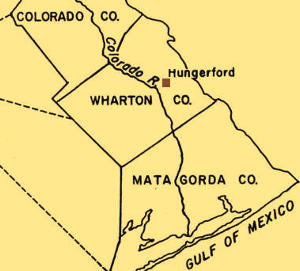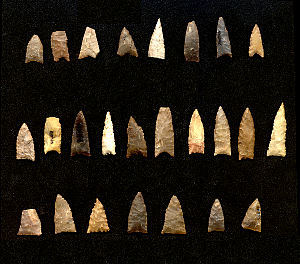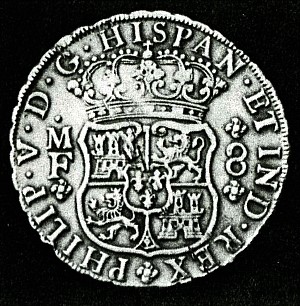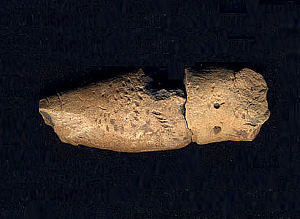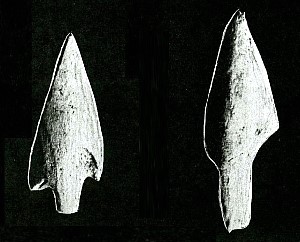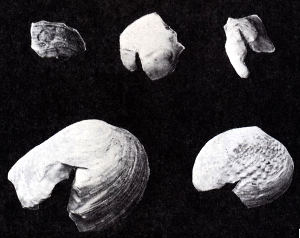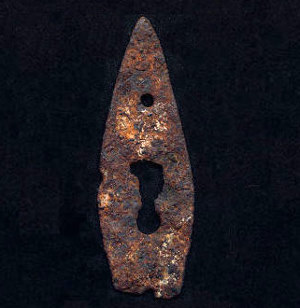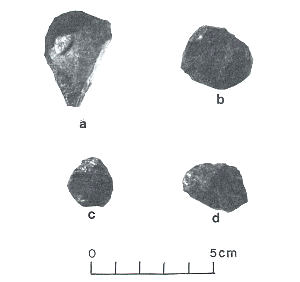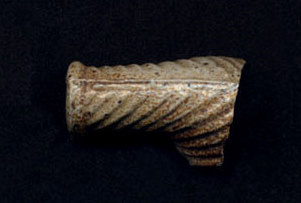Shanklin Site
The Shanklin Site (41WH8) was a predominately Late Prehistoric/Historic period native encampment on a tributary of the Colorado River known as Peach Creek in Wharton County, Texas. Covering an area roughly half the size of a football field (35x50 meters), the site was located on a small rise above the creek. The area had been cultivated in modern times, exposing a variety of chipped-stone tools and weaponry, native pottery fragments and shell ornaments.
Lithic and shell debris and a great variety of animal bone indicated a variety of resources were exploited and a number of activities took place at the site. Of particular interest were several native-modified glass and metal objects indicating contact with Europeans.
Artifacts were collected on the surface and from within the plow zone (about 6-8 inches, or 15-20 centimeters in depth) by area rancher and long-time archeological steward Joe Hudgins, who monitored the site in the 1960s and 1970s. He also conducted random shovel tests to gauge the depth of the site, but no artifacts were found below this level.
A considerable amount of chipped stone artifacts indicate Historic period Indian occupation. These include over 100 arrow points of types Fresno, Guerrero, Cuney and bulbar stemmed varieties. The small triangular Guerrero points are of particular value in establishing an Historic period date for at least part of the site's occupation. These small triangular points have been found in a number of South Texas missions and other 18th-century Spanish Colonial sites. Other stone artifacts found at the site were 10 small cores, 10 bifaces, 150 small unifacial end scrapers, 23 drills and more than 1,250 chert flakes.
Over 8,000 ceramic sherds were collected; of these roughly 40% had decoration in the form of wavy or straight painted black lines typical of Rockport ware. A few sherds had lines or clusters of punctations, and several rim sherds had notched indentations. An unusual fired-clay anthropomorphic figurine was decorated front and back with parallel rows of indentations, similar to fingernail marks, as well as other markings suggesting eyes in the head area. The figurine was 2.56 inches (6.5 cm) long and roughly 1 inch (2.5 cm) in diameter. Also found at the site were marine shell beads, bone beads, including a drilled alligator tooth, and several bone projectile points.
Contact with Europeans was evidenced by bowl and stem fragments from European clay smoking pipes, one unifacially chipped glass end scraper (styled in the same manner as the small stone scrapers), three bifacially worked glass objects, a Spanish silver “piece-of-eight” coin, an iron spike, knife blade, and an iron projectile point shaped from a keyhole escutcheon. Additional glass fragments were heavily patinated suggesting they had lain on the surface for a substantial period of time.
Animal bone collected at the site indicated that the inhabitants exploited a wide variety of species. William McClure of Houston identified these as opossum, turtle, gar, black bear, cougar, rabbit, whitetail deer, alligator, bison (or cow), modern horse, a variety of marine shells (Oliva, Rangia clam, Lightning whelk, Giant Atlantic cockle, Transverse ark, Plicate horn), and freshwater mussel.
Early 16th- and 17th-century records indicate that the native peoples along the lower Colorado River (including modern-day Wharton County) were the Karankawa-affiliated Coco Indians. In 1833, a violent encounter with these Indians was recorded by Daniel Gilleland, one of Stephen F. Austin's original “old 300” colonists. According to an account in J. W. Wilbarger's Indian Depredations in Texas, a party of Karankawa Indians came to Daniel Gilleland's home and demanded corn. The settler refused, causing the chief of the Indian party to fly into a rage and draw his bow to demonstrate his willingness to force the demand. Gilleland seized his gun, and a “stand off” between the two took place, until the Indians retreated. In order to protect his family and his crop, Gilleland gathered a number of men living in the area and attacked the Karankawas at their camp, killing and wounding several of the group. Subsequently, the remaining Indians moved out of the area.
Whether the Shanklin Site represents a campsite of the Indians involved in this struggle likely will never be known. Gilleland's home was located in an area near the present-day town of Glen Flora, about 2.5 miles west of the Shanklin Site. Sightings of Indians in this area continued into the early 1870s, according to J.D. Hudgins of Hungerford. He recalled a small group of Indians who visited his ranch during the summer and stayed for days, begging for food. This band of Indians was known by the local inhabitants as fish-eaters, because they lived on the creeks and rivers, depending almost entirely on fish and shellfish for food.
All material and artifacts found on the Shanklin Site, with the exception of the silver coin, were donated to the Texas Archeological Research Laboratory at the University of Texas at Austin.
Contributed by Joe Hudgins.
Sources
Campbell, Thomas N.
1976 Coco Indians: The Handbook of Texas 3:181.
Hudgins, Joe D.
1986 A Historic Indian Site in Wharton County, Texas. Bulletin of the Texas Archeological Society 55 (for 1984). Download article![]()
Wilbarger, J. W.
1889 Daniel Gilleland. In Indian Depredations in Texas. Reprinted 1985, Eakin Press, Austin.
